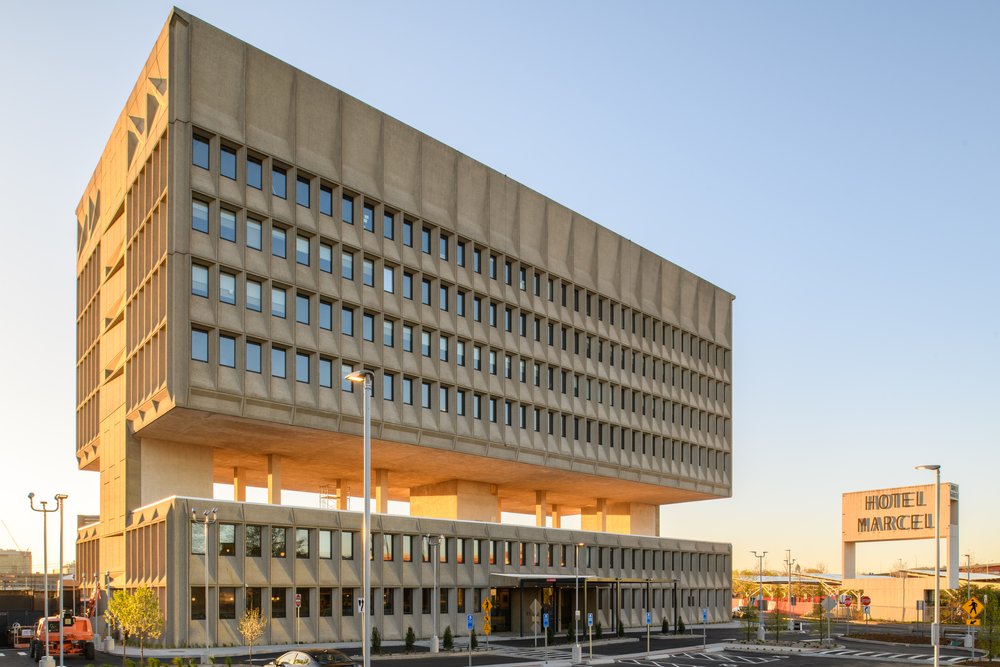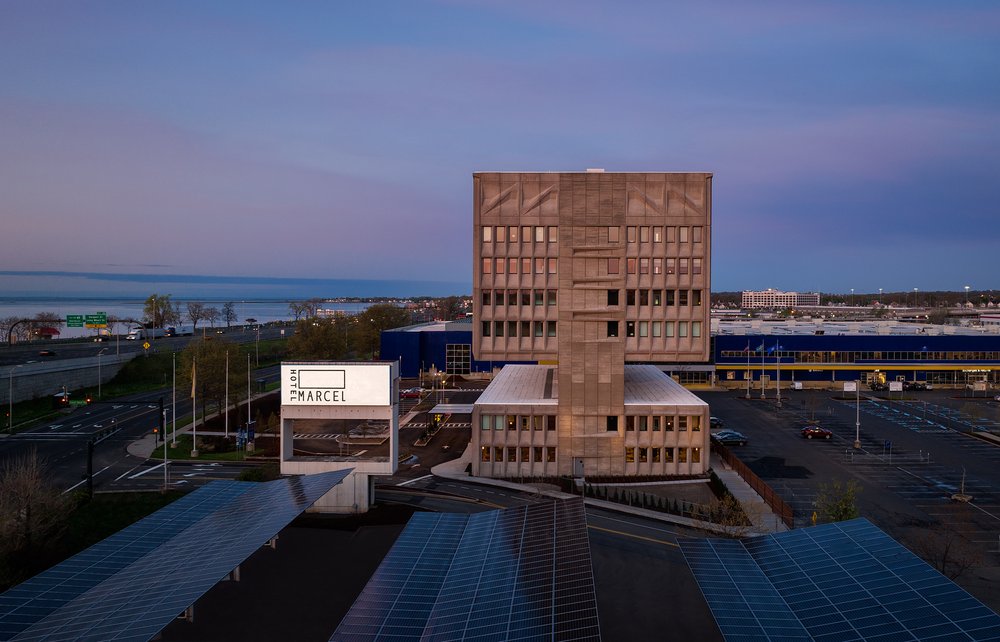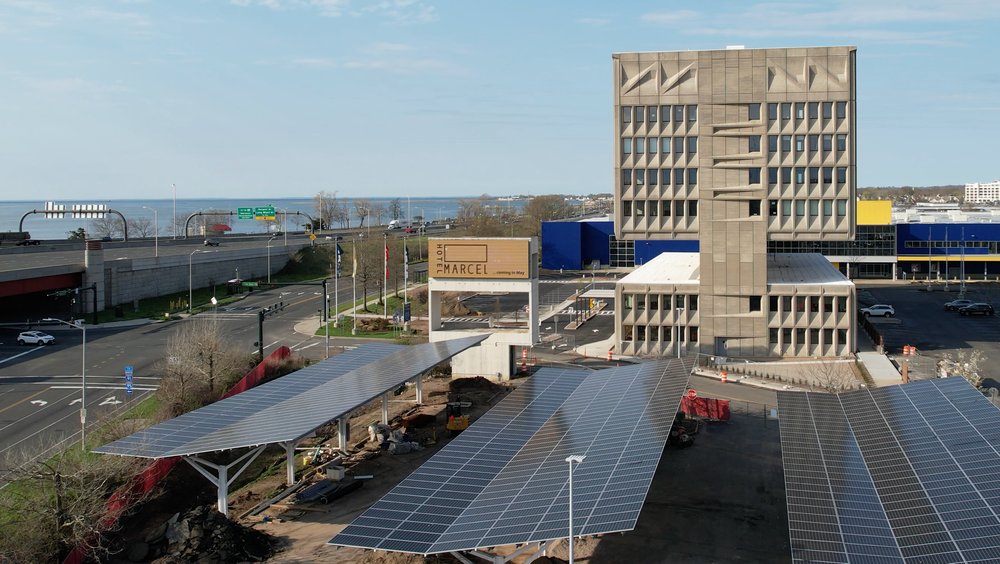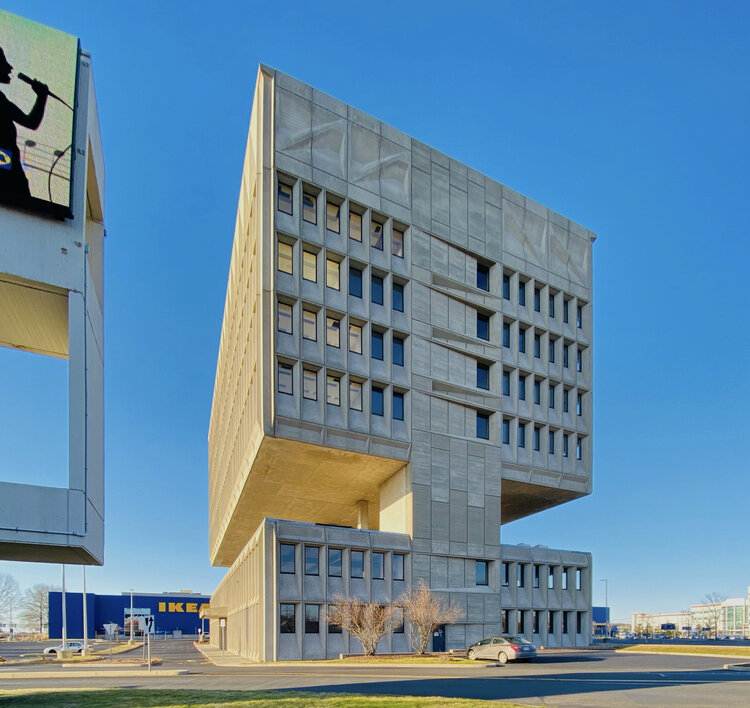After standing vacant for 20 years, the historic Hotel Marcel in New Haven, Connecticut — created in the influential Bauhaus design and modernist architectural style — is now an all-electric, LEED Platinum and Passive House example of hotel sustainability. Reflecting the vision of contemporary architect Bruce Becker, the hotel is powered by a microgrid modeled using HOMER Grid software.

The 165-room Hotel Marcel marries a deep renovation to improve energy efficiency and new renewable energy investments with the preservation of a historic midcentury architectural landmark. Bauhaus architect Marcel Breuer designed the building in 1967 to serve as an office and research facility for the Armstrong Rubber Company, and it reopened in 2022 as Hotel Marcel. It’s a notable example of Brutalist architecture, often characterized by raw concrete and imposing forms that dramatically express the weight and mass of a building. With a commanding, boxy structure that nonetheless seems to float weightlessly in space above a two-story podium below, a thin sliver of sky separating the two, Hotel Marcel is an unmistakable landmark in the coastal Long Wharf area of New Haven, Connecticut.
Connecticut architect Bruce Becker bought the building in 2020, spurred by the personal challenge of creating a net-zero hotel on a property on the Connecticut Register of Historic Places.
“It’s important to recognize the amount of carbon emissions that are embedded in the built infrastructure. For that reason, it’s much better to refurbish old buildings than to construct new ones,” Becker said.
Becker lives in Westport, Connecticut, near the hotel, and is passionately committed to sustainability. “Westport floods every time there’s a full moon,” he reported, lamenting the noticeable sea level changes. “I’ve sworn off fossil fuels,” Becker added, describing the Tesla power walls at his house and explaining why he chose to build a microgrid for Hotel Marcel. “Once you have solar and batteries, it’s only natural to get a grid-forming inverter.”

Renovating Hotel Marcel
Working with a small team from Becker & Becker, his architectural and development firm, Becker set out to do a “deep energy retrofit” on the building before tackling the creation of the microgrid. He described his admiration for the original structure and its architect, saying, “Breuer had a fascination with light and shadow, and because of the deep-set windows, this building has natural shading.”
The first thing the team did was gut the interior of the building, removing asbestos and installing highly efficient windows. They also implemented what Becker believes are the first commercial-scale heat pumps for domestic hot water used in a hotel in the United States (U.S.). The team also installed power-over-ethernet (or “smart”) lighting tied to the building’s state-of-the-art energy management system for easy control.
Recently, Travel and Leisure rated Hotel Marcel among its “100 Best New Hotels,” partly because of its all-electric “eco-friendly” character and historically meticulous postmodern, minimalist interior design.

Hotel Marcel uses 80% less energy than a typical U.S. hotel and is 60% more efficient than local building codes require. The building is LEED Platinum certified and expected to be the first Passive House-certified hotel in the U.S. It is slated to reach net zero by the summer of 2024 after the construction of additional solar and battery resources. While LEED covers a wide range of metrics from sustainable building materials to energy use, Becker said that Passive House is a construction concept that focuses on a well-insulated building envelope, use of the sun to provide passive heating, and other technologies that reduce the need for conventional heating and cooling systems. With a focus on energy efficiency and comfort, the ventilation system in Passive House construction often supplies ample fresh air — also a feature of Hotel Marcel. According to Becker, energy-efficient renovations enable two-thirds of the building’s overall reduced energy consumption, while renewable energy provides the remaining energy savings.
The Hotel Marcel microgrid and energy incentives
Designed in collaboration with Ageto Energy and modeled with HOMER Grid software from UL Solutions, the Hotel Marcel microgrid will protect the building from power outages while also reducing energy costs and carbon emissions. Another benefit is service to the community: Becker had the hotel designated as a critical facility for first responders. If the regional grid goes down, authorities can base emergency operations in the hotel.
The Hotel Marcel microgrid currently consists of 457 kilowatts (kW) of solar photovoltaic power mounted on the roof and solar canopies in the parking lot. Inside the building, Becker is currently expanding one megawatt (MW) of battery storage to 1.5 MW. The microgrid also features two EPC Power Corporation 250 kW power inverters that can smoothly switch from grid-following while on utility power to grid-forming when the building goes off-grid.

Ageto Energy Application Engineer Laura Williams said there is no provision for backup generation powered by carbon-based fuels. The omission of a backup generator is significant because the microgrid includes ample energy storage resources that can provide backup power for the hotel. The microgrid meets the hotel’s strict code requirements for electricity that can power emergency lighting and pumps that will operate sprinklers in case of fire. She also noted that the Hotel Marcel microgrid called for a complete system backup, including all electrical circuits, rather than just backing up critical loads, which is often the case in microgrid design.
To ensure that the renewable energy and energy storage systems can meet the power requirements, Hotel Marcel has a strict load management protocol that goes into effect when there is a grid outage. The load management system interfaces with the building and elevator management systems. For example, the building’s biggest electrical load is the industrial dryers. When the power system status switches to the microgrid, lights flash in the laundry room to alert operators to turn off two 150 kW dryers and implement temporary energy savings.
Because the transition to backup power is so seamless and quiet without the rumbling of backup generators, Williams said the staff wasn’t aware when the hotel went off the grid. “Since they wouldn’t know they had to conserve energy, we had to implement a system of alarms,” she explained. Now, when the hotel switches to off-grid power, key staff members get text alerts urging them to implement the load management protocols.
Energy cost saving through peak shaving and incentives
In addition to its renewable energy generation, the hotel’s battery participates in a multi-state program to help stabilize energy supply and demand on the grid with ISO New England, the region’s electric transmission provider. When ISO New England sends a dispatch signal, the microgrid battery at the hotel can inject energy back into the grid. This capability is designed primarily to be available on the hottest summer days, when air conditioning systems have increased the electric load, causing power demand to outstrip utilities’ ability to supply electricity. However, the battery can also absorb energy if the grid overproduces solar power. Although this has not yet occurred, the hotel is required to test the functionality twice a year.
The hotel also manages its demand charges through a peak-shaving program, and HOMER software has helped Ageto Energy design and manage that capability. Williams said peak shaving avoids the high costs incurred when utility customers experience a spike in power use. She explained that she used HOMER software modeling to create a demand limit. While the building load may reach a peak of 800 kW, the battery dispatch strategy limits the peak usage of grid energy to 600 kW, reducing the hotel’s energy bills. Meanwhile, Ageto software monitors the load and solar production; when power usage threatens to push the hotel over its demand limit, Ageto controls draw upon renewable energy or batteries to meet the need.
“It is a mix of art and science knowing what the hotel’s electricity needs are going to be,” Williams said, noting that during the microgrid’s design phase, the team underestimated the electric loads.
Now, informed by a year’s worth of data, the building owners can estimate electric loads more precisely. Williams said the Ageto team will import the annual load estimates into HOMER Grid software each year, updating the microgrid model and setting new demand limits if necessary.

What’s the future for Hotel Marcel?
Becker has his sights set on continuing to build out his vision for a renewable energy-powered historic hotel. By 2024, he plans to add another 500 kW of energy storage and additional solar to bring Hotel Marcel to net zero greenhouse gas emissions. He is also interested in enhancing the energy conservation system to manage individual rooms’ temperatures and is considering powering the parking lot electric vehicle charging stations with renewable energy. Becker envisions that the innovations will continue into the future.
Bauhaus-style architect Marcel Breuer’s iconic building, which revolutionized architecture in its day, has now been updated with a new kind of revolution: low-carbon, energy-efficient renovation, and energy systems that provide a pathway to the future.

UL Solutions HOMER Grid is a market-leading solar-plus-storage software tool for designing grid-tied distributed energy systems. With an integrated utility tariff database and a new module for electric vehicle charging stations, it optimizes peak shaving to help commercial and industrial utility customers lower their demand charges. HOMER Grid can model projects with wind and combined heat and power as well as islanded systems, helping users improve their resiliency. Explore your opportunities with HOMER Grid during a complimentary trial. Learn more and download your complimentary trial.
